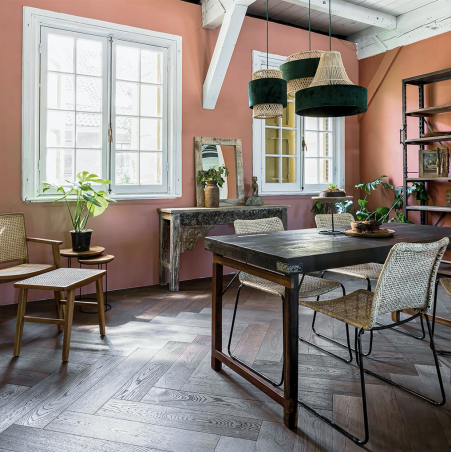In an era where sustainability is not just a trend but a necessity, the use of reclaimed wood in furniture design has gained significant traction. This case study delves into the creation of a reclaimed wood dining table, exploring its journey from sourcing to craftsmanship, and its impact on both the environment and the consumer. The table, named “Heritage Harvest,” serves as a testament to the beauty of upcycling and the enduring appeal of handcrafted furniture.
Background
Reclaimed wood refers to timber that has been salvaged from old buildings, barns, warehouses, and other structures, often dating back decades or even centuries. This wood is repurposed to create new products, reducing the demand for freshly harvested timber and minimizing waste. The Heritage Harvest dining table is a prime example of how reclaimed wood can be transformed into a functional and aesthetically pleasing piece of furniture.
Sourcing the Wood
The journey of the Heritage Harvest table began in the rural heartlands of Pennsylvania, where a 19th-century barn stood as a silent witness to generations of agricultural history. The barn, no longer in use, was slated for demolition. However, instead of letting the aged wood go to waste, a local reclamation company stepped in to salvage the timber.
The reclamation process involved carefully dismantling the barn, piece by piece, to ensure the integrity of the wood was preserved. The wood, primarily oak and pine, showed signs of wear and tear, including nail holes, knots, and natural weathering. These imperfections, rather than being seen as flaws, were celebrated as unique characteristics that would add to the table’s rustic charm.
Design and Craftsmanship
Once the wood was sourced, it was transported to a workshop in Brooklyn, New York, where a team of skilled artisans took over. The lead designer, Emily Carter, envisioned a dining table that would not only be functional but also tell a story. The design brief was clear: create a piece that honored the wood’s history while incorporating modern industrial and reclaimed dining tables aesthetics.
The table’s design featured a sturdy, plank-style top with a live edge, showcasing the natural contours of the wood. The base was constructed from reclaimed iron beams, salvaged from an old factory, adding an industrial touch that complemented the rustic top. The dimensions were carefully considered to accommodate six to eight people comfortably, making it ideal for family gatherings and dinner parties.
The craftsmanship involved in creating the Heritage Harvest table was meticulous. Each piece of wood was cleaned, sanded, and treated to remove any contaminants while preserving its natural patina. The artisans paid special attention to the joinery, using traditional techniques such as dovetail and mortise-and-tenon joints to ensure durability. The iron base was sandblasted to remove rust and then powder-coated for a sleek finish.
Environmental Impact
The use of reclaimed wood in the Heritage Harvest table significantly reduced its environmental footprint compared to a table made from newly harvested timber. By repurposing wood that would otherwise have been discarded, the project prevented the release of stored carbon into the atmosphere. Additionally, the reclamation process required less energy and resources than logging and milling new wood.
The iron base, too, contributed to the table’s sustainability credentials. By salvaging and repurposing industrial materials, the project minimized the need for new metal production, which is energy-intensive and often involves mining and refining processes that can harm the environment.
Consumer Appeal
The Heritage Harvest table was launched at a high-end furniture boutique in Manhattan, where it quickly garnered attention from design enthusiasts and environmentally conscious consumers. Its unique blend of rustic charm and modern elegance resonated with a wide audience, from urban dwellers seeking a connection to nature to families looking for a durable and meaningful centerpiece for their homes.
One of the key selling points was the table’s story. Each piece came with a certificate of authenticity, detailing the origin of the wood and the history of the barn from which it was salvaged. This narrative added an emotional layer to the purchase, making the table not just a piece of furniture but a conversation starter and a family heirloom in the making.
Challenges and Solutions
Despite its success, the creation of the Heritage Harvest table was not without challenges. One of the main issues was the variability of reclaimed wood. Each piece had its own unique characteristics, which made standardization difficult. The artisans had to carefully select and match pieces to ensure consistency in color and texture.
Another challenge was the cost. Reclaimed wood, particularly high-quality pieces with historical significance, can be more expensive than new timber. Additionally, the labor-intensive nature of the craftsmanship added to the overall price. To address this, the designers positioned the table as a premium product, targeting consumers who valued sustainability and craftsmanship over affordability.
Conclusion
The Heritage Harvest dining table is more than just a piece of furniture; it is a symbol of sustainability, craftsmanship, and the enduring beauty of reclaimed materials. Its journey from a dilapidated barn to a high-end boutique showcases the potential of upcycling to create products that are both environmentally friendly and aesthetically pleasing.
As the demand for sustainable furniture continues to grow, the Heritage Harvest table serves as a model for how designers and manufacturers can meet this demand while preserving the planet’s resources. It is a testament to the idea that the past can be reimagined and reborn, creating a legacy that transcends time.
Future Prospects
The success of the Heritage Harvest table has inspired its creators to expand their line of reclaimed wood furniture, including coffee tables, bookshelves, and bedroom sets. They are also exploring partnerships with architects and interior designers to incorporate reclaimed materials into larger projects, such as restaurants and hotels.

Moreover, the company is committed to educating consumers about the benefits of reclaimed wood and the importance of sustainable practices. Through workshops, exhibitions, and online content, they aim to foster a greater appreciation for the craftsmanship and environmental impact of upcycled furniture.
In a world where the choices we make today will shape the future, the Heritage Harvest dining table stands as a beacon of hope, proving that beauty and sustainability can go hand in hand.
Please login or Register to submit your answer









